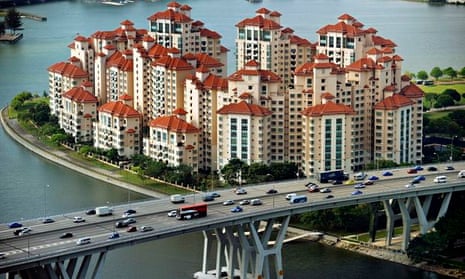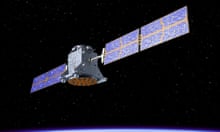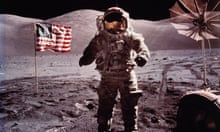With 5.6 million people living in an area of 270 sq miles (700 sq km), the authorities in Singapore have invested heavily in public transport in an effort to reduce the numbers on the roads. But, like other metropolitan hubs, they faced the inevitable problem of heavy congestion at peak time between 8am and 8.45am.
Part of the solution has come in the form of an incentive for passengers: if they registered their smart travel cards and commuted in the hour after these peak times, they would earn points which can be used in a raffle to win cash.
The scheme was the result of work by California-based Urban Engines, which uses data from travel cards, like the Oyster card in London, along with GPS data from trains and buses to draw up a detailed model of how the residents of a city move through their transport system. The results in turn show where problems lay. Drawing up this living profile in Singapore and the subsequent incentives resulted in a drop of peak hour travel of between 7% and 13%, according to the company.
“All these things are piecemeal and siloed at this point but it is really a jigsaw puzzle. If you actually put together the information that is coming from smart cards and from GPSs, then you can start figuring out what are the true traffic patterns in a city,” said Shiva Shivakumar, a co-founder and chief executive of the company. “Every single bus, every single train, every single road segment, every single time. You can start seeing the patterns emerge from that. What happens when there is a big event going on? What happens if it rains? What happens when there is fog?” added Shivakumar, who spent 10 years at Google working on Gmail and Google Maps among other projects.
Another of the company’s founders, Balaji Prabhakar, specialises in keeping internet sites running when they are getting heavy traffic. When he was stuck in heavy car traffic in Bangalore in 2007, he pondered whether the two problems could be solved in a similar way. Separately, Shivakumar was questioning whether his work in Google in making the email system faster could also be put to use in urban traffic situations. The pair came together in Stanford, California, to work on the problem and apply large amounts of data to make cities move more fluidly.
“How do we use some of the ideas that we had on the web … in terms of the real world and make the mobility experience a lot faster and better?” said Shivakumar. “There is a fundamental growing problem around the world.”
Transport authorities give Urban Engines the commuter fare card information and GPS details of train and bus systems. Fare card information from when commuters tap in and out allows the company to gauge the commuting pattern – how long people are waiting, the number of trains which passed which were too full to get on – and concludes how a system is working at any one time.
“We take all that information with our data sets which have information about the entire city – all the roads, all the buses, all the trains. We take all that with the online city information which is open. There is a lot of open data – for example for roads, where are the bus stops? Where are the train stations, how long does it take to get from one train station to the next bus stop? We have processed that already, very similar to Google maps or Apple maps. We take all of that information and build up an analytical platform for all of that information,” said Shivakumar.
In practice, the information which is fed back to the transport authority is shown on a screen with a copy of the grid of the railway or bus system. It shows each individual train or bus snaking around their route with meters above them showing how full each one is. Figures illustrate how many commuters are in each station and the waiting times.
By analysing this information, it can be decided where more trains and buses are needed or, if that is not possible, how commuters can be incentivised to travel outside of peak times in order to lessen the loads, as in Singapore, or else encourage commuters to move to an underused station as opposed to one which is over capacity.
The pilot study for the system was conducted in Bangalore where incentives such as lottery tickets were used to switch an estimated 17% of commuters from their regular pattern. Another study took place in Stanford. The system is now being used in Sao Paulo in Brazil to help manage the 17,000-strong bus fleet while it is in its early stages in Washington DC.
“They [transport authorities] have had average data until now which has been working well for them for a while but now the commuter patterns are changing quite a bit more,” said Shivakumar.
“In the US they have a 45mph speed limit on certain roads. That is an optimal speed that you want to go, and the reason that came about is because there was a research study a few years back where they looked at what is happening on average.
“And so a lot of the decisions have been made from average data as opposed to, in some cases, you want to go at a much higher speed or a much lower speed depending on the weather conditions. That is what is now possible because of the data. You can make much more nuanced decisions about how to optimise your networks.”
Attempting to tackle congestion, which is estimated to cost economies multiple billions every year, has attracted the attention of some heavyweight investors to Urban Engines. So far, Google chairman, Eric Schmidt, and Google Ventures are among those who have put money into the early-stage company, although how much or a valuation for the firm has not yet been released.
Traditional methods
If transport managers want to understand and locate congestion hotspots, conventional methods have been to send human surveyors to watch and analyse their results, or else use video cameras to assess the information across a range of different stations, according to Shivakumar. Another method is to use weighing scales for trains and work out the number on board by dividing by the average weight. “But they don’t have weighing scales for platforms for example if you want to know how many people are waiting at each station,” he said.











Comments (…)
Sign in or create your Guardian account to join the discussion